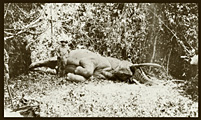

Only once in American history had a President vacated the White House and then returned to it again as President. This had been Grover Cleveland's unique destiny in 1893. That this had occurred within recent memory, and to a politician in whose footsteps Roosevelt had followed as governor of New York and finally as President, must have given Roosevelt reason to pause as he himself became a private citizen again in March 1909.
 He was only fifty years old, the youngest man to leave the executive office. Cleveland had been just eighteen months older when he temporarily yielded power to Benjamin Harrison in 1889. For the record, Roosevelt claimed that he was through with politics. This was the only thing he could have said as William Howard Taft, his successor, waited in the wings. Theodore Roosevelt had enjoyed being President as much as any person possibly could. Filling the post-White House vacuum would require something big and grand, and with that in mind, Roosevelt planned his immediate future. The prospect of a yearlong safari in Africa brightened for him what otherwise would have been the dreary prospect of retirement. It "will let me down to private life without that dull thud of which we hear so much," he wrote.
He was only fifty years old, the youngest man to leave the executive office. Cleveland had been just eighteen months older when he temporarily yielded power to Benjamin Harrison in 1889. For the record, Roosevelt claimed that he was through with politics. This was the only thing he could have said as William Howard Taft, his successor, waited in the wings. Theodore Roosevelt had enjoyed being President as much as any person possibly could. Filling the post-White House vacuum would require something big and grand, and with that in mind, Roosevelt planned his immediate future. The prospect of a yearlong safari in Africa brightened for him what otherwise would have been the dreary prospect of retirement. It "will let me down to private life without that dull thud of which we hear so much," he wrote.
Aided by several British experts, Roosevelt oversaw every preparation: itinerary, gear and clothing, food and provisions, weapons, personnel, and expenses. He had been an avid naturalist and hunter since the days of his youth. Because he was genuinely interested in the African fauna, he arranged for his safari to be as scientific as possible, and enticed the Smithsonian Institution to join the expedition by offering to contribute extensively to its fledgling collection of wildlife specimens. Roosevelt invited his son, Kermit, along for companionship, if the lad would be willing to interrupt his first year of studies at Harvard. Kermit needed no persuading.
![]()
Past Exhibitions | National Portrait Gallery Home